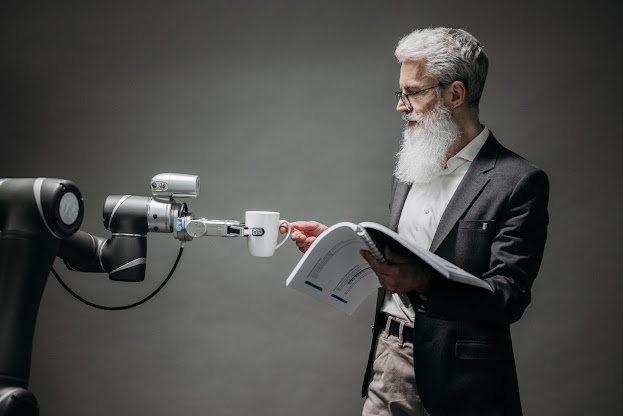Recalibrating assumptions on AI

Welcome to Tech Trends and Solutions. This Blog is dedicated to exploring and explaining the latest technological trends and innovative solutions in the tech industry. From cutting-edge gadgets and software to emerging trends and advancements in AI, VR, and IoT, this blog provides insightful and informative content for tech enthusiasts and professionals alike. Whether you are a tech expert or just starting, this blog has something for everyone interested in the world of technology.

Virtual reality (VR) has rapidly evolved from a science fiction concept to a fully functional technology that is changing the way we experience entertainment, education, and even our daily lives. VR immerses users in a digital world, providing them with an interactive and realistic experience through the use of specialized equipment and software. In this article, we will explore the technology behind VR, its various applications, and the potential benefits and drawbacks of its use.
At its core, VR technology creates a virtual environment that simulates the real world using a combination of computer-generated imagery (CGI), sound effects, and haptic feedback. The user typically wears a VR headset that tracks their head movements, allowing them to look around and interact with the environment. Other peripherals such as hand-held controllers or full-body suits can provide additional sensory feedback, enhancing the immersive experience.The applications of VR are vast and varied. In the entertainment industry, VR is being used to create immersive video games and virtual theme parks. For example, a VR headset can transport the user to a fantastical realm where they can explore, fight monsters, and interact with other players in real-time. VR is also being used in the film industry to create interactive movie experiences that allow the user to become part of the story.
In the field of education, VR is being used to provide immersive and engaging learning experiences. For example, medical students can use VR to practice surgical procedures in a virtual environment, providing them with valuable hands-on experience without the risks associated with live procedures. VR can also be used to simulate real-world scenarios in fields such as military training, disaster preparedness, and space exploration.
While the potential benefits of VR are numerous, there are also some drawbacks and limitations to its use. The most obvious limitation is the high cost of equipment and software required to run VR applications. Additionally, prolonged use of VR can cause motion sickness, eye strain, and other physical discomforts. There are also concerns that excessive use of VR could lead to addiction, social isolation, and a disconnection from reality.
Despite these limitations, VR technology continues to advance rapidly, and its potential applications are only limited by our imagination. As the technology becomes more widespread and affordable, it is likely that VR will become an increasingly common part of our daily lives.
Advantage of Virtual Reality
Virtual reality (VR) is a technology that creates a simulated environment that can be experienced through a VR headset or other specialized equipment. VR has numerous advantages, and its potential applications are vast and varied. In this article, we will explore the benefits of VR and how it is transforming various industries.
One of the most significant advantages of VR is its ability to provide users with immersive experiences. By simulating a realistic environment, VR can transport users to different places and allow them to interact with digital objects and people in real-time. This can be particularly valuable in fields such as gaming, where VR can provide an unparalleled level of immersion and engagement.
VR is also being used to create enhanced learning experiences. For example, medical students can use VR to practice surgical procedures in a virtual environment, providing them with valuable hands-on experience without the risks associated with live procedures. In addition, VR can be used to simulate real-world scenarios in fields such as military training, disaster preparedness, and space exploration.
VR can also increase accessibility for individuals who may have difficulty accessing traditional forms of entertainment, education, or travel. For example, individuals with physical disabilities can use VR to experience activities that may be challenging or impossible in the physical world. Additionally, VR can provide virtual tours of locations that may be difficult to access due to geographic or financial constraints.
Another advantage of VR is its ability to reduce costs in various industries. For example, VR can be used to simulate product prototypes, reducing the need for costly physical prototyping. VR can also be used to conduct virtual meetings and training sessions, reducing the need for travel and associated expenses.
VR can also improve safety in various fields. For example, construction workers can use VR to simulate hazardous scenarios and practice safety procedures without risking injury. Similarly, pilots can use VR to simulate emergency situations and practice emergency procedures without risking the safety of passengers.
Virtual reality is a technology with numerous advantages that are transforming various industries. Its ability to provide immersive experiences, enhance learning, increase accessibility, reduce costs, and improve safety make it a valuable tool in numerous applications. As VR technology continues to advance and become more widely available, it is likely that we will see even more innovative uses of this transformative technology.
Disadvantage of Virtual Reality
Virtual reality (VR) is a technology that has rapidly evolved in recent years, providing users with immersive and engaging experiences. While there are many potential benefits to VR, such as enhanced learning and increased accessibility, there are also some drawbacks and limitations to its use. In this article, we will explore the disadvantages of VR and some of the potential risks associated with its use.
1. Physical discomfort One of the most common disadvantages of VR is the physical discomfort that can occur during and after use. Prolonged use of VR can cause motion sickness, eye strain, and other physical discomforts. In some cases, users may experience headaches, dizziness, and nausea.
Comments
Post a Comment